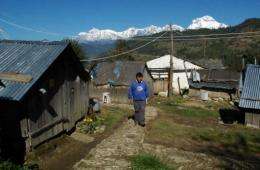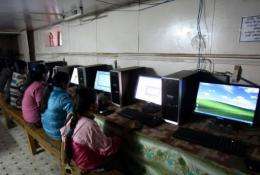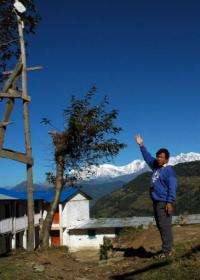Wi-Fi lifeline reaches remote Himalayas

It used to take teacher Mahabir Pun more than two days to check his email from his home in the remote Himalayan village of Nagi in western Nepal.
The 55-year-old would walk for seven hours to the nearest road before taking a three-hour bus ride along precarious mountain tracks to the only town in the area with an Internet connection.
Today, all Pun has to do is log on to the wireless network he has set up over the past few years, catapulting more than 100 impoverished villages in Nepal into the 21st century.
The technology has transformed lives in some of the most inhospitable places on earth, where there are no roads or hospitals and where most people scratch out a meagre living as subsistence farmers.
It allows communities to access vital medical expertise via videolink, stay in touch with loved-ones abroad, and even sell their yaks, goats and chickens online on www.nepalwireless.com -- a sort of e-Bay for local farmers.
"We chose areas where no commercial Internet service provider would ever go," says Pun, who estimates that around 70,000 people can access the network.
"When we started, almost no one in rural Nepal was using the Internet. Now we have connected more than 100 villages. But that is nothing, there are thousands more villages like these in Nepal."
It all started when Pun travelled to the United States in the 1990s to study for a masters degree. The Internet was just becoming popular, and one of his professors suggested they set up a web site for his home village.
It was one of the first Internet sites to mention Nepal, and by the time he returned home, Pun was being bombarded by messages from people around the world who wanted to visit the 800-strong mountain community.
"At that time, not even businesses in (the capital) Kathmandu had websites, but Nagi did," he told AFP in his native village, 2,200 metres (7,200 feet) up in the Himalayas.
"I was getting emails from all sorts of people including doctors and college professors, and they all wanted to know what they could do to help our village. So I invited them to come and volunteer."
Pun decided his students should learn about this emerging new technology, but the school could not afford to buy a computer. So he asked everyone who came to bring a component, and set about teaching himself to build one.
He organised a collection centre in the backpacker district of Kathmandu, and managed to put together around a dozen makeshift computers, building them in wooden crates and distributing them to schools in the area.
But it was not until 2002 that, with the help of volunteer students, a plan was formed to hook up the village to the Internet using a wi-fi connection from the nearest major town, Pokhara.

There were myriad challenges. No one had ever tried to build a wi-fi network at such a high altitude before, and a series of relay towers had to be built to beam the signal through the narrow valleys.
All the construction materials had to be carried up the mountain by hand along with the solar panels needed for power. The highest stands at 3,600 metres, and is manned by a yak farmer who has to check the connections daily.
Mains electricity had still not reached any of the villages, and to make things even more difficult, Nepal was in the grip of a bloody Maoist insurgency and Nagi had fallen completely under the control of the leftist guerrillas.
"The Maoists had eyes everywhere. They used to come and ask lots of questions, but they didn't know much about the Internet," says Pun.
"All the parts we used were totally illegal. If the army had come here more frequently, they would have put a stop to it."
Once again, Pun asked his foreign volunteers to bring what they could to help -- customs officials, he reasoned, would be unlikely to suspect Western backpackers of smuggling in contraband communications equipment.
Nagi was the first village to be connected, and by September 2003, five villages in Myagdi district, around 200 miles (300 kilometres) north-west of Kathmandu, were accessing the network.
Now, Pun operates two networks that connect more than 100 villages to the Internet -- a significant achievement in a country where just 6.3 percent of people have online access.

In 2007 he was awarded the prestigious Ramon Magsaysay prize -- widely viewed as the Asian equivalent of the Nobel -- for community leadership.
But he is determined to avoid the world of "conferences, resolutions and commitments," and has said he only accepted because the 50,000-dollar prize could help put more villages online.
To keep costs down, Pun travels around the country by public bus and works from a tiny office in his family home.
The local Internet service provider charges a discounted rate of 45,000 rupees (640 dollars) a month for the connection, with the cost shared between dozens of villages in the area.
In Nagi, they have set up a paper-making business to raise funds, and Pun is working with the government to create a new trekking route he hopes will bring much-needed tourist dollars to the villages.
In the packed computer room at Nagi school, the impact on the community is clear.
At one terminal sits 63-year-old Amar Pun whose three children, like many Nepalese, have moved abroad, unable to find work in their home country.
"They send news of their lives by email and I send back news of the village. It feels great to be in touch, I love hearing from them," he says.
Teenagers chat on Facebook to friends in neighbouring villages, watch Nepalese pop music on YouTube and look up the latest gossip on their favourite football players.
In the village clinic, health worker Rupa Pun connects every morning to a Kathmandu hospital using a webcam, allowing patients to be seen by doctors hundreds of miles away.
"It used to take sick patients two days to get down into the valley for treatment. They had to be carried in a basket or on a makeshift stretcher," she says.
"Before, we could only treat minor illnesses here. Now the doctor can give his diagnosis and send the right drugs up here if we don't already have them. It has made a huge difference to our lives."
(c) 2010 AFP

















